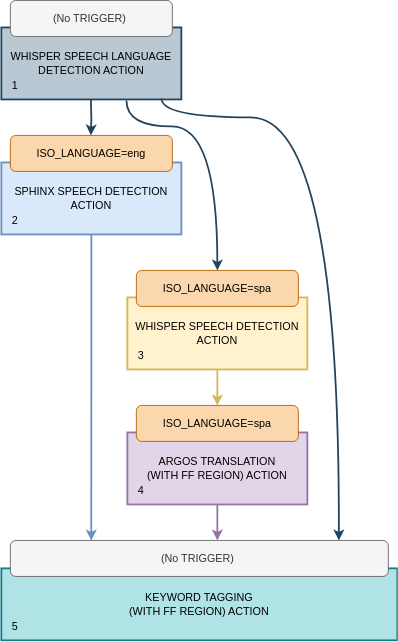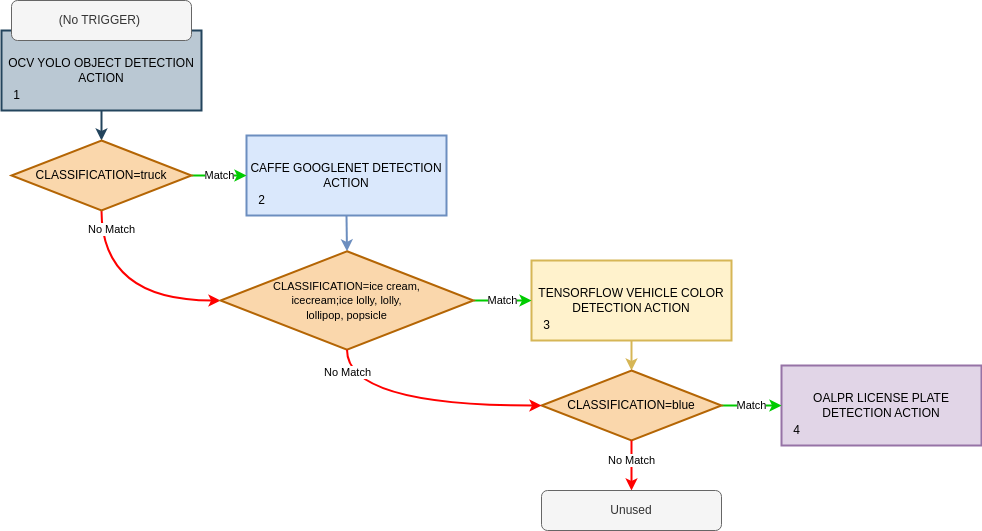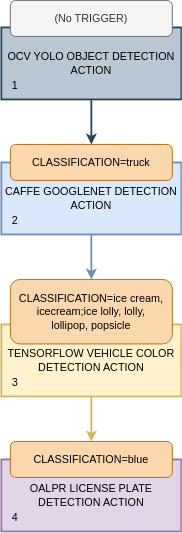NOTICE: This software (or technical data) was produced for the U.S. Government under contract, and is subject to the Rights in Data-General Clause 52.227-14, Alt. IV (DEC 2007). Copyright 2023 The MITRE Corporation. All Rights Reserved.
Trigger Overview
The TRIGGER property enables pipelines that use feed forward to have
pipeline stages that only process certain tracks based on their track properties. It can be used
to select the best algorithm when there are multiple similar algorithms that each perform better
under certain circumstances. It can also be used to iteratively filter down tracks at each stage of
a pipeline.
Syntax
The syntax for the TRIGGER property is: <prop_name>=<prop_value1>[;<prop_value2>...].
The left hand side of the equals sign is the name of track property that will be used to determine
if a track matches the trigger. The right hand side specifies the required value for the specified
track property. More than one value can be specified by separating them with a semicolon. When
multiple properties are specified the track property must match any one of the specified values.
If the value should match a track property that contains a semicolon or backslash,
they must be escaped with a leading backslash. For example, CLASSIFICATION=dog;cat will match
"dog" or "cat". CLASSIFICATION=dog\;cat will match "dog;cat". CLASSIFICATION=dog\\cat will
match "dog\cat". When specifying a trigger in JSON it will need to doubly escaped.
Algorithm Selection Using Triggers
The example pipeline below will be used to describe the way that the Workflow Manager uses the
TRIGGER property. Each task in the pipeline is composed of one action, so only the actions are
shown. Note that this is a hypothetical pipeline and not intended for use in a real deployment.
- WHISPER SPEECH LANGUAGE DETECTION ACTION
- (No TRIGGER)
- SPHINX SPEECH DETECTION ACTION
- TRIGGER:
ISO_LANGUAGE=eng - FEED_FORWARD_TYPE:
REGION
- TRIGGER:
- WHISPER SPEECH DETECTION ACTION
- TRIGGER:
ISO_LANGUAGE=spa - FEED_FORWARD_TYPE:
REGION
- TRIGGER:
- ARGOS TRANSLATION ACTION
- TRIGGER:
ISO_LANGUAGE=spa - FEED_FORWARD_TYPE:
REGION
- TRIGGER:
- KEYWORD TAGGING ACTION
- (No TRIGGER)
- FEED_FORWARD_TYPE:
REGION
The pipeline can be represented as a flow chart:

The goal of this pipeline is to determine if someone in an audio file, or the audio of a video file, says a keyword that the user is interested in. The complication is that the input file could either be in English, Spanish, or another language the user is not interested in. Spanish audio must be translated to English before looking for keywords.
We are going to pretend that Whisper language detection can return multiple tracks, one per language detected in the audio, although in reality it is limited to detecting one language for the entire piece of media. Also, the user wants to use Sphinx for transcribing English audio, because we are pretending that Sphinx performs better than Whisper on English audio, and the user wants to use Whisper for transcribing Spanish audio.
The first stage should not have a trigger condition. If one is set, it will be ignored. The
Workflow Manager will take all of the tracks generated by stage 1 and determine if the trigger
condition for stage 2 is met. This trigger condition is shown by the topmost orange diamond. In this
case, if stage 1 detected the language as English and set ISO_LANGUAGE to eng, then those
tracks are fed into the second stage. This is shown by the green arrow pointing to the stage 2 box.
If any of the Whisper tracks do not meet the condition for the stage 2, they are later considered as possible inputs to stage 3. This is shown by the red arrow coming out of the stage 2 trigger diamond pointing down to the stage 3 trigger diamond.
The Workflow Manager will take all of the tracks generated by stage 2, the
SPHINX SPEECH DETECTION ACTION, as well as the tracks that didn't satisfy the stage 2 trigger, and
determine if the trigger condition for stage 3 is met.
Note that the Sphinx component does not generate tracks with the ISO_LANGUAGE property, so
it's not possible for tracks coming out of stage 2 to satisfy the stage 3 trigger. They will later
flow down to the stage 4 trigger, and because it has the same condition as the stage 3 trigger, the
Sphinx tracks cannot satisfy that trigger either.
Even if the Sphinx component did generate tracks with the ISO_LANGUAGE property, it would be set
to eng and would not satisfy the spa condition (they are mutually exclusive). Either way,
eventually the tracks from stage 2 will flow into stage 5.
The Workflow Manager will take all of the tracks generated by stage 3, the
WHISPER SPEECH DETECTION ACTION, as well as the tracks that did not satisfy the stage 2 and 3
triggers, and determine if the trigger condition for stage 4 is met. All of the tracks produced by
stage 3 will have the ISO_LANGUAGE property set to spa, because the stage 3 trigger only
matched Spanish tracks and when Whisper performs transcription, it sets the ISO_LANGUAGE property.
Since the stage 4 trigger, like the stage 3 trigger, is ISO_LANGUAGE=spa, all of the tracks
produced by stage 3 will be fed in to stage 4.
The Workflow Manager will take all of the tracks generated by stage 4, the
ARGOS TRANSLATION (WITH FF REGION) ACTION, as well as the tracks that did not satisfy the stage 2,
3, or 4 triggers, and determine if the trigger condition for stage 5 is met. Stage 5 has no trigger
condition, so all of those tracks flow into stage 5 by default.
The above diagram can be simplified as follows:

In this diagram the trigger diamonds have been replaced with the orange boxes at the top of each stage. Also, all of the arrows for flows that are not logically possible have been removed, leaving only arrows that flow from one stage to another.
What remains shows that this pipeline has three main flows of execution:
- English audio is transcribed by the Sphinx component and then processed by keyword tagging.
- Spanish audio is transcribed by the Whisper component, translated by the Argos component, and then processed by keyword tagging.
- All other languages are not transcribed and those tracks pass directly to keyword tagging. Since there is no transcript to look at, keyword tagging essentially ignores them.
Further Understanding
In general, triggers work as a mechanism to decide which tracks are passed forward to later stages of a pipeline. It is important to note that not only are the tracks from the previous stage considered, but also tracks from stages that were not fed into any previous stage.
For example, if only the Sphinx tracks from stage 2 were passed to Whisper stage 3, then stage 3
would never be triggered. This is because Sphinx tracks don't have an ISO_LANGUAGE property. Even
if they did have that property, it would be set to eng, not spa, which would not satisfy the
stage 3 trigger. This is mutual exclusion is by design. Both stages perform speech-to-text. Tracks
from stage 1 should only be processed by one speech-to-text algorithm (i.e. one SPEECH DETECTION
stage). Both algorithms should be considered, but only one should be selected based on the language.
To accomplish this, tracks from stage 1 that don't trigger stage 2 are considered as possible inputs
to stage 3.
Additionally, it's important to note that when a stage is triggered, the tracks passed into that stage are no longer considered for later stages. Instead, the tracks generated by that stage can be passed to later stages.
For example, the Argos algorithm in stage 4 should only accept tracks with Spanish transcripts. If
all of the tracks generated in prior stages could be passed to stage 4, then the spa tracks
generated in stage 1 would trigger stage 4. Since those have not passed through the Whisper
speech-to-text stage 3 they would not have a transcript to translate.
Filtering Using Triggers
The pipeline in the previous section shows an example of how triggers can be used to conditionally
execute or skip stages in a pipeline. Triggers can also be useful when all stages get triggered. In
cases like that, the individual triggers are logically ANDed together. This allows you to produce
pipelines that search for very specific things.
Consider the example pipeline defined below. Again, each task in the pipeline is composed of one action, so only the actions are shown. Also, note that this is a hypothetical pipeline and not intended for use in a real real deployment:
- OCV YOLO OBJECT DETECTION ACTION
- (No TRIGGER)
- CAFFE GOOGLENET DETECTION ACTION
- TRIGGER:
CLASSIFICATION=truck - FEED_FORWARD_TYPE:
REGION
- TRIGGER:
- TENSORFLOW VEHICLE COLOR DETECTION ACTION
- TRIGGER:
CLASSIFICATION=ice cream, icecream;ice lolly, lolly, lollipop, popsicle - FEED_FORWARD_TYPE:
REGION
- TRIGGER:
- OALPR LICENSE PLATE TEXT DETECTION ACTION
- TRIGGER:
CLASSIFICATION=blue - FEED_FORWARD_TYPE:
REGION
- TRIGGER:
The pipeline can be represented as a flow chart:

The goal of this pipeline is to extract the license plate numbers for all blue trucks that have photos of ice cream or popsicles on their exterior.
Stage 2 and 3 do not generate new detection regions. Instead, they generate tracks using the same
detection regions in the feed-forward tracks. Specifically, if YOLO generates truck tracks in
stage 1, then those tracks will be fed into stage 2. In that stage, GoogLeNet will process the
truck region to determine the ImageNet class with the highest confidence. If that class corresponds
to ice cream or popsicle, those tracks will be fed into stage 3, which will operate on the same
truck region to determine the vehicle color. Tracks corresponding to blue trucks will be fed
into stage 4, which will try to detect the license plate region and text. OALPR will operate on
the same truck region passed forward all of the way from YOLO in stage 1.
Tracks generated by any stage in the pipeline that don't meet the three trigger criteria do not flow into the final license plate detection stage, and are therefore unused.
It's important to note that the possible CLASSIFICATION values generated by stages 1, 2, and 3 are
mutually exclusive. This means, for example, that YOLO will not generate a blue track in stage 1
that will later satisfy the trigger for stage 4.
Also, note that stages 1, 2, and 3 can all accept an optional ALLOW_LIST_FILE property that can be
used to discard tracks with a CLASSIFICATION not listed in that file. It is possible to recreate
the behavior of the above pipeline without using triggers and instead only using allow list files to
ensure each of those stages can only generate the track types the user is interested in. The
disadvantage of the allow list approach is that the final JSON output object will not contain all of
the YOLO tracks, only truck tracks. Using triggers is better when a user wants to know about those
other track types. Using triggers also enables a user to create a version of this pipeline where
person tracks from YOLO are fed into OpenCV face. person is just an example of one other type of
YOLO track a user might be interested in.
The above diagram can be simplified as follows:

Removing all of the flows that aren't logically possible, or result in unused tracks, only
leaves one flow that passes through all of the stages. Again, this flow essentially ANDs the
trigger conditions together.
JSON escaping
Many times job properties are defined using JSON and track properties appear in the JSON output
object. JSON also uses backslash as its escape character. Since the TRIGGER property and JSON both
use backslash as the escape character, when specifying the TRIGGER property in JSON, the string
must be doubly escaped.
If the job request contains this JSON fragment:
{ "algorithmProperties": { "DNNCV": {"TRIGGER": "CLASS=dog;cat"} } }
it will match either "dog" or "cat", but not "dog;cat".
This JSON fragment:
{ "algorithmProperties": { "DNNCV": {"TRIGGER": "CLASS=dog\\;cat"} } }
would only match "dog;cat".
This JSON fragment:
{ "algorithmProperties": { "DNNCV": {"TRIGGER": "CLASS=dog\\\\cat"} } }
would only match "dog\cat". The track property in the JSON output object would appear as:
{ "trackProperties": { "CLASSIFICATION": "dog\\cat" } }